NADIS Cattle Report and Forecast – May 2006
NADIS is a network of 40 veterinary practices and six veterinary colleges monitoring diseases in cattle sheep and pigs in the UK. NADIS data can highlight potential livestock disease and parasite incidence before they peak, providing a valuable early warning for the month ahead. NADIS disease forecasts are written specifically for farmers,
to increase awareness of prevalent conditions and promote disease prevention and control,
in order to benefit animal health and welfare.
The forecasts are based on national trends and farmers are advised to discuss
their individual farm circumstances with their veterinary surgeon.
ADULT CATTLE
Fertility
The number of fertility problems followed its usual seasonal fall in April. As most herds have now turned out their cattle, now is an opportune moment to examine the trends in fertility during this winter housing period. The NADIS reports show that around 9000 missed heats were recorded this winter, which is about average for that period. This means that around 3% of all cattle covered by NADIS veterinarians were presented as not seen bulling because a heat had been missed. This is a major cost to the dairy industry. In veterinary fees alone the cost per farm was ₤15. This of course assumes that all farms are presenting all of their not-seen bulling cows to their veterinarian. So for farms that do the veterinary costs are much higher. Indeed including the costs for treatment, increased calving to conception interval and other costs and assuming that around 25% of cows with missed heats are presented to vets, the average cost of missed heats over the winter per farm was in the region of ₤2000. These figures obviously refer to farms which have a planned veterinary fertility programme. The cost on farms that don’t is likely to be even higher. There is clearly a major problem with heat detection; cows that have not been seen bulling are over 15 times more likely to be cycling than not. Indeed the number of cases of anoestrus has declined significantly over the last four years and this winter’s total reports (571) is only 83% of the winter average for the previous 4 winters and only 68% of the average number of reports in 1997 to 2001. So why is heat detection not working. Reports from many farms suggest that cows are not in heat for as long and don’t show heat so well. This is undoubtedly down to genetics and increased milk yield but means we need to pay more attention to heat detection not less. Perhaps the fact that the number of missed heats hasn’t gone up despite these changes means that heat detection has actually improved (as otherwise the number of cases would have gone up)! Nevertheless this is an area that cost NADIS farms over ₤million per year and which needs more attention
Figure 1: Number of missed heats reported by NADIS vets over the last five winters.
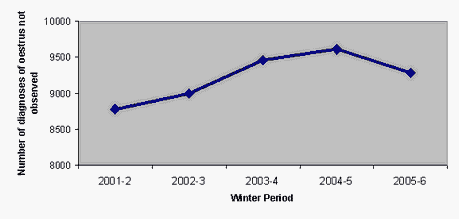
The number of cases of uterine infection remained high in April, although there were fewer reports than in March the numbers were 25% above the long-term average. These high levels are likely to be associated with significant fertility problems later in the year. Cows with infection problems need to be checked before they are served, even if they have been treated previously, as targeted treatment at that time is the most effective way of improving fertility. The NADIS data suggest that this problem is likely to persist at least until the end of May; particularly as turn-out has been late on many farms. Undoubtedly the problem on many farms can be linked to insufficient calving space. Ensuring that calving areas are as clean as possible should now be a priority, especially if environmental conditions mean that calving outdoors is not possible.
Figure 2: Comparison of the number of cases of uterine infection reported in 2005 and 2006 with the mean for 1997 to 2004
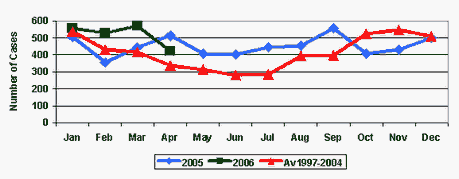
The NADIS data show that the coming three months (June to August) tend to be the months when most abortions are reported. So now is a good time to review your plan for dealing with abortion. Individual cases will always occur so you need to set an intervention level that triggers action. This needs good records to work properly; it is probably worthless examining a near-term abortion when you have a problem around four months of gestation. The simple rule when collecting material sample is to collect everything. In particular collect the placenta; this is often forgotten and can provide valuable information as to cause.
One NADIS vet reported an abortion outbreak in April which was linked to infection with both Neospora and BVD. These two pathogens are the most important infectious causes of abortion and there is growing evidence that they act together synergistically. Thus if you have an outbreak of Neospora-related abortion, it is worthwhile checking the BVD status and, if the herd is susceptible, vaccinating. In the outbreak reported to NADIS, BVD vaccination reduced but did not eliminate the problem. No vaccine against Neospora is currently available in the UK; one is available in New Zealand, but recently published data suggest that it is less than effective! We need more research on Neospora vaccination.
Metabolic disease
In contrast to most years the number of cases of displaced abomasum (DA) seems to have peaked this year in March rather than in April. However, despite the reduction in the number of cases, the number of reports is still more than twice the number of reports for the same month in 1997-2001. Indeed the number of cases reported by NADIS veterinarians so far this exceeds the yearly totals for any year between 1997 and 2001. There has been a sudden dramatic change in the incidence of this disease. As yet the incidence is still relatively low, with less than 1% of cattle affected but overall it has increased almost three-fold for no obvious reason. We need further investigation.
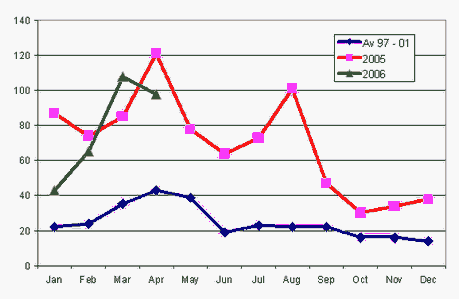
In addition to being the peak DA month, April is usually the start of the spring rise in grass staggers (hypomagnesaemia). The rise this year has been lower than normal. This is almost certainly the result of the delayed turnout on many farms. This means that May could be worse than average, particularly as the current weather forecast suggest that we are in for a spell of good grass growth. Hypomagnesaemia is a classic example of a disease where clinical cases are just the tip of the iceberg and where subclinical cases cost far money than clinical cases. Hypomagnesaemia can be tackled in a number of ways including increasing magnesium in the feed or water, pasture dusting with magnesium oxide, reducing or counteracting high potassium or nitrogen levels, and by management changes to ensure hungry animals do not go outside by ensuring roughage intake is satisfactory to prevent rapid grass intake. Prevention is the key.
Figure 4: The seasonal pattern of grass staggers reports by NADIS veterinarians
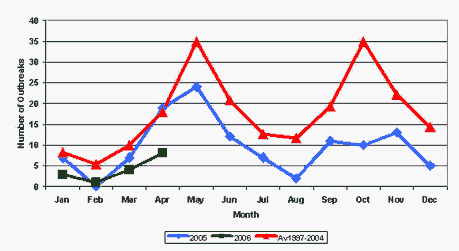
Cattle lameness
Despite reports from NADIS vets in some areas of increases in lameness treatments, overall the figure is fairly static with total lameness reports following the pattern of previous years but at a figure about 10% below average. All four of the main diseases (white line disease, sole ulcer, foul-in-the-foot and digital dermatitis) had fewer reports than average and all, except for digital dermatitis had fewer reports than this time last year.
Figure 5: Seasonality in the number of reports of foul-in-the-foot by NADIS veterinarians.
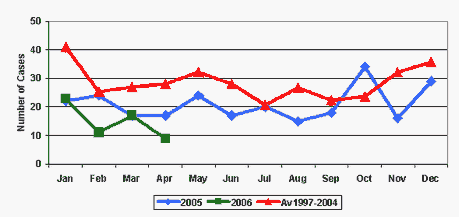
CALVES
The number of calf scour outbreaks reported in April, as in March, was significantly below average. So far this year the usual spring rise hasn’t been as high as normal. However, we shouldn’t be complacent, significant scour problems are still common in May so for farms that have had low levels so far this year cleaning and disinfection is still essential to provide a good environment for the next batch of calves.
In contrast, navel-ill and related problems, which have been at relatively low levels this winter, increased to average in April. Last year May’s figures were greater than April’s so control of navel-ill is another reason to pay attention the environment, so that significant problems in the next few months can be prevented.
Copyright © NADIS 2006 www.nadis.org.uk
| FURTHER INFORMATION | SPONSORS’ LINK |
| • To find out more about EBLEX, click here |
| FURTHER INFORMATION | SPONSORS’ LINK |
| • To find out more about cattle mastitis click here |
| FURTHER INFORMATION | SPONSORS’ LINK |
| • To find out more about the HCC click here |
| FURTHER INFORMATION | SPONSORS’ LINK |
| • To find out more about QMS click here |
| FURTHER INFORMATION | SPONSORS’ LINK |
| • Supporting British Livestock click here |





